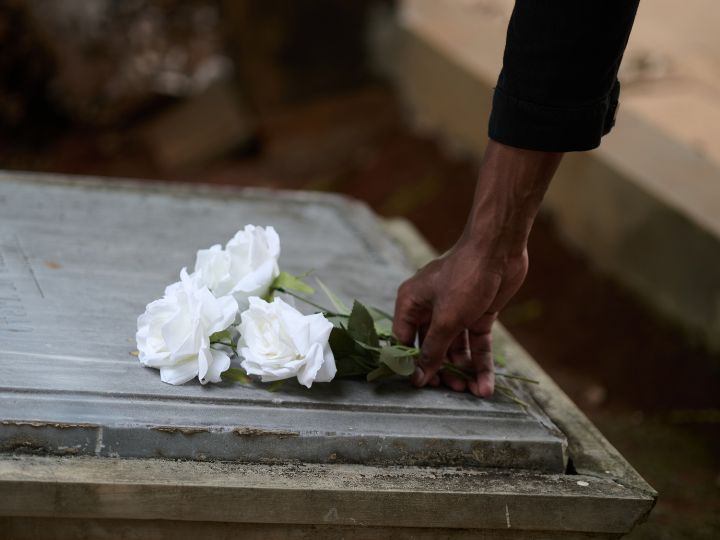Complete Guide to Monument Materials: Stone Types & Durability
New Title

When you're choosing a monument to honor a loved one, you're not just making a decision about today—you're making one that will stand the test of time, often for generations to come. Here in Lawrence County, we understand the importance of quality stone and lasting craftsmanship. At GW Monuments, we've helped families throughout Bedford and beyond select the perfect materials for their memorials. In this guide, we'll walk you through everything you need to know about monument materials, from granite headstones to marble options, so you can make an informed choice that feels right for your family.
Understanding Your Monument Material Options
When it comes to creating a lasting tribute, the material you choose matters tremendously. Stone isn't just stone—different types have distinct characteristics, durability profiles, and aesthetic qualities that affect how your memorial will look and perform over decades. Let's explore the main options and what makes each unique.
Granite: The Gold Standard for Monument Materials
Granite is by far the most popular choice for monuments and headstones, and there are good reasons why. This natural igneous rock forms deep beneath the earth's surface under intense heat and pressure, creating an incredibly dense and durable material.
Why granite headstones stand out:
Granite is composed of interlocking mineral crystals—primarily feldspar, quartz, and mica—that create a structure that's extremely resistant to weathering and erosion. This is why you'll see granite monuments that have survived for over a century with minimal deterioration. The density of granite means it resists moisture penetration far better than softer stones, making it ideal for outdoor memorial settings where it will face rain, snow, freeze-thaw cycles, and UV exposure.
The color palette available in granite is remarkable too. From classic blacks and grays to warm rose, pink, and burgundy tones, each granite variety offers its own character. Many families find that granite's versatility allows them to select a stone that feels deeply personal—whether that's a sophisticated deep black granite or a warm multi-colored granite with natural patterns.
Durability of granite monuments:
When properly maintained, a granite headstone can last indefinitely. We're talking centuries, not decades. The Mohs hardness scale—which rates mineral hardness from 1 to 10—ranks granite at about 7, making it harder than most environmental stressors it will encounter. This is a stone that doesn't easily scratch, chip, or crack from normal weathering.
Marble: Classic Elegance with Special Considerations
Marble is undeniably beautiful. Its smooth, elegant appearance and natural veining make it a choice for those seeking a more refined, classical aesthetic. Marble has a long history as a monument material—after all, some of the world's most famous monuments were crafted from marble. However, marble requires a more nuanced understanding of its strengths and limitations.
The beauty and the challenge:
On the Mohs hardness scale, marble rates around 3 to 4—significantly softer than granite. This doesn't mean marble monuments will fall apart, but it does mean they require different care considerations. Marble is also more porous than granite, which means it absorbs moisture more readily. In climates with freeze-thaw cycles (which we certainly experience here in Indiana!), this porosity can be problematic. Water enters the stone, freezes, expands, and can cause micro-fractures over time.
That said, marble ages beautifully in certain conditions. Some families love the way marble develops a subtle patina as it weathers, creating a distinguished appearance that speaks to the passage of time and memory.
When marble works best:
Marble is an excellent choice if your monument will be primarily protected—such as inside a mausoleum or in a covered memorial garden. For outdoor headstones in Indiana, many families choose marble for the front-facing engraved side while opting for a more weather-resistant stone for the back and base. This gives you the aesthetic benefits of marble where they matter most while protecting the monument's longevity.
Granite vs. Marble: Making the Comparison
So which should you choose? Here's a straightforward comparison:
Granite wins on durability and weather resistance. It's the better choice if your monument will face the full outdoor elements in a cemetery setting, especially in Indiana where we experience significant seasonal changes.
Marble wins on elegance and traditional beauty. If aesthetics are your primary concern and you're willing to invest in more regular maintenance or can protect the stone in a covered setting, marble offers a timeless, sophisticated appearance.
Granite is more budget-friendly. Generally speaking, granite monuments cost less than comparable marble options, though pricing varies based on specific stone types, colors, and customization.
Marble may require more maintenance. We'll discuss maintenance in depth below, but know that marble needs more attentive care, especially in outdoor settings.
For most families choosing outdoor cemetery monuments in the Midwest, granite is the most practical and sensible choice. But the right material ultimately depends on your specific needs, location, and vision for the memorial.
The Longevity Question: How Long Will Your Monument Last?
This is perhaps the most important question families ask us. When you're investing in a monument, you're making a decision you hope will last forever.
Granite longevity: A well-constructed granite monument with proper maintenance can easily last 300 years or more. Many of the granite monuments we see in older cemeteries show remarkable preservation. Granite essentially weathers at a rate of about 1 inch per 10,000 years under normal conditions—meaning the erosion is negligible over any human timeframe.
Marble longevity: Marble monuments can also last for centuries, but the timeline depends more heavily on environmental factors. In protected settings or dry climates, marble endures beautifully. In wet, freeze-thaw climates like ours, marble may show more weathering over 100-150 years.
The role of workmanship: Here's something many people don't realize: the quality of construction matters as much as the stone itself. How is the monument set? What's holding the base together? Are the engravings properly sealed? At GW Monuments, we take pride in our craftsmanship because we know that a beautifully selected stone is only as good as its installation. We serve families in Bedford, Shoals, and throughout the region with the same attention to detail that ensures your monument will be a lasting tribute.
Maintenance and Care: Keeping Your Monument Beautiful
Proper maintenance significantly extends your monument's life and keeps it looking beautiful for generations.
Granite monument care:
Granite requires relatively little maintenance, which is one reason it's so popular.
Here's what we recommend:
- Annual inspection: Once a year, visit the monument and check for any cracks, chips, or signs of water pooling at the base.
- Gentle cleaning: Clean the monument with soft brushes and mild soap or specialized stone cleaner. Avoid harsh chemicals or pressure washers, which can damage the surface and engravings.
- Avoid acidic cleaners: Never use vinegar, lemon, or other acidic solutions on any monument stone. These can etch and discolor the surface.
- Seal as needed: Granite naturally has some pores, and applying a stone sealer every 3-5 years helps protect against staining and moisture infiltration.
- Check the base: Make sure the base remains secure and that water isn't pooling around the monument's foundation.
Marble monument care:
If you've chosen marble or have a marble component in your monument:
- Clean regularly: Marble shows water spots more readily than granite, so regular gentle cleaning helps maintain its appearance.
- Avoid acidic solutions: This is even more critical for marble than granite. Never use vinegar or acidic cleaners—they can etch marble permanently.
- Seal regularly: Marble benefits from professional sealing every 1-2 years, particularly in outdoor settings.
- Address weathering promptly: If you notice erosion of engravings or surface deterioration, consult a professional. Early intervention can prevent more significant damage.
- Watch for freeze-thaw damage: After particularly harsh winters, inspect marble monuments carefully for new cracks or chips.
- Professional restoration:If your monument needs restoration after years of weathering, professional stone restoration experts can often repair damage, re-engrave worn areas, or even replace damaged sections.
This is why choosing a high-quality monument with proper installation from the start makes such a difference.
Preparing Your Monument for Winter: A Seasonal Angle
Living in Indiana means preparing for winter weather—and your monument needs the same consideration as your home. Here's how to help your memorial weather the cold season successfully.
Pre-winter monument maintenance:
As fall transitions to winter, take these steps to protect your monument:
- Clean thoroughly: Remove leaves, dirt, and debris that might trap moisture against the stone. Clean gutters or landscaping around the monument's base.
- Check drainage: Make sure water drains away from the monument. If water pools at the base during rain or snowmelt, it can cause problems. Consider redirecting drainage with landscaping adjustments if needed.
- Seal before the freeze: If your monument is granite, a fresh sealing before winter provides protection against moisture that might freeze and cause damage.
- Inspect the foundation: Ensure the monument's base is solid and level. Frost heave—where frozen ground expands—can sometimes shift monuments. If you notice any shifting or settling, contact a professional immediately.
- Address any cracks: Even hairline cracks can collect water that will freeze and expand, widening the crack. Identify and address any damage before winter arrives.
During winter:
- Avoid salt and ice melt near the monument: Rock salt and calcium chloride can damage stone over time. If you must use them nearby, rinse the monument with fresh water after the thaw.
- Don't scrape directly on the stone: If snow builds up on your monument, gently brush it off rather than scraping with metal tools.
- Regular inspection: Even in winter, check on the monument periodically. Note any new cracks or damage that might need spring repairs.
- Spring assessment: As winter ends, give your monument a thorough inspection. Any damage from freeze-thaw cycles should be addressed promptly before further weathering occurs. This is a great time to clean the monument and apply fresh sealer if needed.
Choosing the Right Stone for Your Family
At the end of the day, selecting monument materials is a deeply personal decision. You're not just choosing stone—you're choosing how your loved one will be remembered and honored for generations to come.
Here are a few questions to guide your thinking:
Where will the monument be located? Outdoor cemetery settings need weather-resistant materials like granite. Protected indoor settings offer more flexibility.
What's your climate and local weather? In Indiana with our seasonal freeze-thaw cycles, granite is generally the more practical choice. However, families who prefer marble can make it work with appropriate care and covering.
What aesthetic speaks to you? This matters too. Some families feel strongly about the deep elegance of black granite or the classical beauty of marble. Your emotional connection to the material is important.
What's your maintenance capacity? If regular seasonal care feels manageable, you have more options. If you prefer minimal ongoing attention, granite is ideal.
What's your budget? Granite typically offers exceptional value—a beautiful, durable monument at a reasonable price. Marble is lovely but generally costs more and requires more maintenance.
Our Commitment to You
Whether you're choosing a granite headstone or exploring marble options, the team at GW Monuments is here to help. We've served families throughout Bedford, Shoals, and Lawrence County with custom monuments and engravings that honor loved ones with care, quality, and craftsmanship.
We understand that this is more than a transaction—it's a tribute. That's why we take time to listen to your vision, explain your options thoroughly, and ensure that every monument we create is built to last and beautiful to behold.
If you'd like to discuss monument materials, see samples of our work, or get started on creating a lasting memorial, we'd love to hear from you. Visit us at [your address], call us at [your phone number], or reach out through our website at gwmonuments.com. We're here to help you create a monument that truly honors your loved one.





